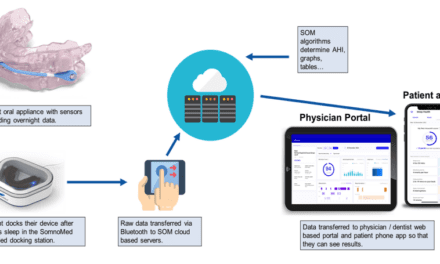New efficacy data published in 2022 suggests that ProSomnus [IA] and ProSomnus EVO can perform better than previous oral appliance clinical studies suggest.
Study results demonstrating that an at-home mandibular repositioning device can accurately identify patients who will respond to oral appliance therapy were published too late—the March 2022 issue of the Journal of Clinical Sleep Medicine (JCSM)1—to have relevance to the usage of the MATRx Plus repositioning device evaluated in the investigation. Zephyr Sleep Technologies, makers of MATRx Plus, ceased operations in June 2021, citing COVID-19-related struggles.
But the prospective clinical study produced some interesting insights on the oral appliance used in the study—the ProSomnus [IA] Sleep Device, says Erin Mosca, PhD, who was manager, clinical and regulatory affairs at Zephyr when the study was conducted in 2017 and 2018, and is now director, medical affairs, at oral appliance maker ProSomnus Sleep Technologies.
In the JCSM study, the oral appliance success rate for the entire population (58 individuals with obstructive sleep apnea) was 81%. “This is higher than generally reported in the literature and is virtually equivalent to that of CPAP. This is astounding,” Mosca says.
The success rates were 100%, 87%, and 64% for participants with mild, moderate, and severe sleep apnea, respectively.
“It is possible that some quality of the ProSomnus oral appliances influenced the overall success rate to the therapy,” the authors wrote in the paper.
Of the 47 individuals who experienced therapeutic success (defined as oxygen desaturation index of less than 10), 33 completed a 6-month follow-up survey. There, the following data was gathered:
- Most participants (84.8%) reported achieving their treatment goal
- 96.7% reported a reduction in snoring volume, with a median reduction of six points on a 10-point scale
- 68.8% reported improved sleep quality, with a median improvement of four points on a 10-point scale
- 61.3% reported increased daytime energy levels, with a median increase of 3 points.
A small proportion of participants reported irritation to their teeth (12.1%) or jaw (15.2%); dryness (3.0%); excessive salivation (6.1%); and sleep disturbance (3.0%) as a result of oral appliance therapy. About a quarter (27.3%) reported experiencing bite changes.
In a further analysis of the data presented at SLEEP 2022, ProSomnus-affiliated authors find, “The rate of therapeutic success was higher than that reported previously in the literature and might be a result of the precision of appliances generated from digital intraoral scans using a CAD/CAM approach.”2
ProSomnus also recently shared results of a study it conducted on its ProSomnus EVO Sleep and Snore Device. Also presented at SLEEP 2022, data from a cohort of 55 patients—15 of whom had mild OSA, 23 moderate, and 17 severe—showed an average pretreatment apnea hypopnea index (AHI) of 26.4 and a 75% improvement when treated with ProSomnus EVO. Overall, 62% resolved to below an AHI of 5 (100% of mild, 65% of moderate, and 24% of severe patients).3
“Healthcare providers cite poor and uncertain efficacy as a reason they are reluctant to prescribe traditional OAT [oral appliance therapy] devices, even for patients who refuse or fail CPAP,” says Len Liptak, ProSomnus CEO, in a release. “This investigation adds to a growing body of clinical data indicating that precision OAT devices, a new category of intraoral medical devices that reposition and stabilize the patient’s mandible with greater precision, mitigates these concerns by delivering more predictable, consistent, efficacious treatment.”
John E. Remmers, MD, chief scientist of ProSomnus, says in a release that sleep apnea “is severely undertreated; changing that will require collaboration and innovation from the sleep medicine community at large. We believe these data continue to validate ProSomnus’s oral appliance therapy devices and suggest that OAT has the potential to improve treatment.”
References
1. Mosca EV, Bruehlmann S, Zouboules SM, et al. In-home mandibular repositioning during sleep using MATRx plus predicts outcome and efficacious positioning for oral appliance treatment of obstructive sleep apnea. J Clin Sleep Med. 2022;18(3):911–9.
2. Murphy M, Remmers J, Mosca E. 0751 The use of a digitally milled oral appliance in the treatment of severe obstructive sleep apnea. Sleep. 2022 June;45 (suppl 1): A327–8.
3. Murphy M, Carollo J, Smith K, Desai A. 0752 Preliminary efficacy of a novel iterative device and material. Sleep. June 2022;45 (suppl_1):A328.
Photo: ProSomnus EVO. Contributed by ProSomnus.





